Mitsubishi Outlander: Economical driving
For economical driving, there are some technical requirements that have to be met. The prerequisite for low fuel consumption is a properly adjusted engine. In order to achieve longer life of the vehicle and the most economical operation, we recommend you to have the vehicle checked at regular intervals in accordance with the service standards. Fuel economy and generation of exhaust gas and noise are highly influenced by personal driving habits as well as the particular operating conditions. The following points should be observed in order to minimize wear of brakes, tyres and engine as well as to reduce environmental pollution.
Starting the engine
Avoid sudden acceleration and sudden starts, as they will increase fuel consumption.
Shifting
Shift only at an appropriate speed and engine speed. Always use the highest gear possible. The drive mode-selector should be set to “2WD” when driving on normal roads and express ways to obtain best possible fuel economy.
City traffic
Frequent starting and stopping increases the average fuel consumption. Use roads with smooth traffic flow whenever possible. When driving on congested roads, avoid use of a low gear at high engine speeds.
Idling
The vehicle consumes fuel even during idling. Avoid extended idling whenever possible.
Speed
At higher the vehicle speed, more fuel is consumed. Avoid driving at full speed. Even a slight release of the accelerator pedal will save a significant amount of fuel.
Tyre inflation pressure
Check the tyre inflation pressures at regular intervals. Low tyre inflation pressure increases road resistance and fuel consumption. In addition, low tyre pressures adversely affect tyre wear and driving stability.
Cargo loads
Do not drive with unnecessary articles in the luggage compartment. Especially during city driving where frequent starting and stopping is necessary, the increased weight of the vehicle will greatly affect fuel consumption. Also avoid driving with unnecessary luggage or carriers, etc., on the roof; the increased air resistance will increase fuel consumption.
Cold engine starting
Starting of a cold engine consumes more fuel. Unnecessary fuel consumption is also caused by keeping a hot engine running. After the engine is started, commence driving as soon as possible.
Air conditioning
The use of the air conditioning will increase the fuel consumption.
Driving, alcohol and drugs
Drunk driving is one of the most frequent causes of accidents. Your driving ability can be seriously impaired even with blood alcohol levels far below the legal minimum. If you have been drinking, don’t drive. Ride with a designated non-drinking driver, call a cab or a friend, or use public transportation. Drinking coffee or taking a cold shower will not make you sober. Similarly, prescription and nonprescription drugs affect your alertness, perception and reaction time. Consult with your doctor or pharmacist before driving while under the influence of any of these medications.
WARNING:
● NEVER DRINK AND DRIVE. Your perceptions are less accurate, your reflexes are slower
and your judgment is impaired.
Safe driving techniques
Driving safety and protection against injury cannot be fully ensured. However, we recommend that you pay extra attention to the following:
Seat belts
Before starting the vehicle, make sure that you and your passengers have fastened your seat belts.
Floor mats
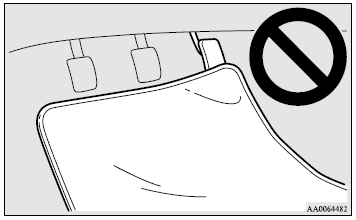
WARNING:
● Keep floor mats clear of the pedals by correctly laying floor mats that are suitable
for the vehicle. To prevent the floor mats from slipping out position, securely
retain them using the hook etc. Note that laying a floor mat over a pedal or laying
one floor mat on top of another can obstruct pedal operation and lead to a serious
accident.
Carrying children in the vehicle
● Never leave your vehicle unattended with the key and children inside the vehicle.
Children may play with the driving controls and this could lead to an accident.
● Make sure that infants and small children are properly restrained in accordance
with the laws and regulations, and for maximum protection in case of an accident.
● Prevent children from playing in the luggage compartment. It is quite dangerous
to allow them to play there while the vehicle is moving.
Loading luggage
When loading luggage, be careful not to load above the height of seats. This is dangerous not only because rearward vision will be obstructed, but also the luggage may be projected into the passenger compartment under hard braking.
Running-in recommendations
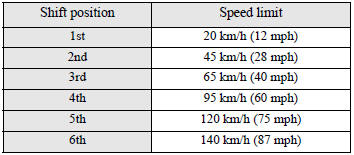
During the running-in period for the first 1,000 km (600 miles), it is advisable
to drive your new vehicle using the following precautions as a guideline to aid
long life as well as future economy and performance.
● Do not race the engine at high speeds.
● Avoid rapid starting, accelerating, braking and prolonged high-speed running.
● Keep to the running-in speed limit shown below. Please note that the legal speed
limits displayed must be adhered to.
● Do not exceed loading limits.
● Refrain from towing a trailer.
Parking brake
To park the vehicle, first bring in to a complete stop, fully engage the parking brake.
To apply
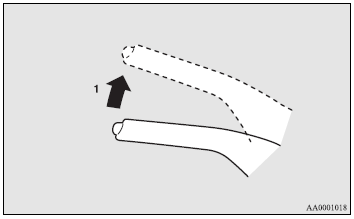
1- Pull the lever up without pushing the button at the end of hand grip.
To release
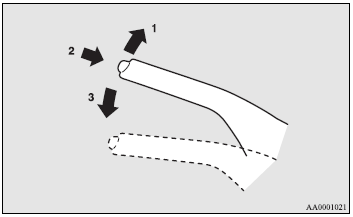
1- Pull the lever up slightly. 2- Push the button at the end of hand grip. 3- Push the lever downward.

CAUTION:
● Before driving, be sure that the parking brake is fully released and brake warning
lamp is off. If you drive without the parking brake fully released, “RELEASE PARKING
BRAKE” will appear on the information screen in the multi-information display. If
a vehicle is driven without releasing the parking brake, the brakes will be overheated,
resulting in ineffective braking and possible brake failure.
Parking
To park the vehicle, fully engage the parking brake, and then move the gearshift lever to 1st or “R” (Reverse) position.
Parking on a hill
To prevent the vehicle from rolling, follow these procedures:
Parking on a downhill
Turn the front wheels toward the kerb and move the vehicle forward until the kerb side wheel gently touches the kerb. Set the parking brake and place the gearshift lever into the “R” (Reverse) position. If necessary, apply chocks to wheels.
Parking on an uphill
Turn the front wheels away from the kerb and move the vehicle back until the kerb side wheel gently touches the kerb. Set the parking brake and place the gearshift lever into the 1st position. If necessary, apply chocks to wheels.
Parking with the engine running
Never leave the engine running while you take a short sleep/rest. Also, never leave the engine running in a closed or poorly ventilated place. Leaving the engine running risks injury or death from accidentally moving the gearshift lever or the accumulation of toxic exhaust fumes on the passenger compartment.
Where you park
WARNING:
● Do not park your vehicle in areas where combustible materials such as dry grass
or leaves can come in contact with a hot exhaust, since a fire could occur.
When leaving the vehicle
Always carry the key and lock all doors and the split tailgate when leaving the vehicle unattended. Always try to park your vehicle in a well lit area.
Steering wheel height adjustment
1. Release the tilt lock lever while holding the steering wheel up. 2. Adjust the steering wheel to the desired height. 3. Securely lock the steering wheel by pulling the tilt lock lever fully upward.
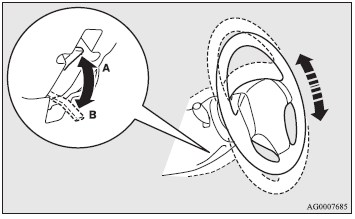
A- Locked. B- Release.
WARNING:
● Do not attempt to adjust the steering wheel while you are driving the vehicle.
Inside rear-view mirror
Adjust the rear-view mirror only after making any seat adjustments so you have a clear view to the rear of the vehicle.
WARNING:
● Do not attempt to adjust the rear-view mirror while driving. This can be dangerous.
Always adjust the mirror before driving.
Adjust the rear-view mirror to maximize the view through the rear window.
To adjust the vertical mirror position
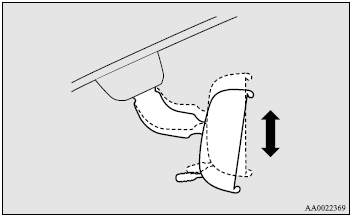
It is possible to move the mirror up and down to adjust its position.
To reduce the glare
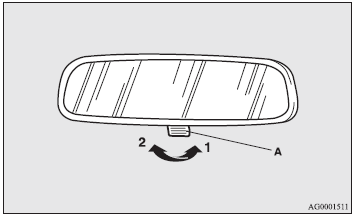
1- Normal. 2- Anti-glare.
The lever (A) at the bottom of the mirror can be used to adjust the mirror to reduce the glare from the headlamps of vehicles behind you during night driving.
See also:
Theft-alarm system
(If installed)
This system is designed to provide protection
from unauthorized entry into the car. This system
is operated in three stages : the first is the
"Armed" stage, the second is the "Alarm" stage
and the third is ...
Towing
If emergency towing is necessary, we recommend having it done by an authorized
Kia dealer or a commercial tow-truck service. Proper lifting and towing procedures
are necessary to prevent damage to the vehicle. The use of wheel dollies or flatbe ...

 Headlamp washer switch*
Headlamp washer switch*